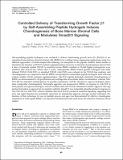| dc.contributor.author | Kopesky, Paul Wayne | |
| dc.contributor.author | Vanderploeg, Eric J. | |
| dc.contributor.author | Kisiday, John D. | |
| dc.contributor.author | Frisbie, David D. | |
| dc.contributor.author | Grodzinsky, Alan J. | |
| dc.date.accessioned | 2011-04-01T22:33:16Z | |
| dc.date.available | 2011-04-01T22:33:16Z | |
| dc.date.issued | 2010-09 | |
| dc.date.submitted | 2010-03 | |
| dc.identifier.issn | 1937-3341 | |
| dc.identifier.issn | 1937-335X | |
| dc.identifier.uri | http://hdl.handle.net/1721.1/62026 | |
| dc.description.abstract | Self-assembling peptide hydrogels were modified to deliver transforming growth factor b1 [beta 1](TGF-b1)[TGF beta 1] to encapsulated
bone-marrow-derived stromal cells (BMSCs) for cartilage tissue engineering applications using two
different approaches: (i) biotin-streptavidin tethering; (ii) adsorption to the peptide scaffold. Initial studies to
determine the duration of TGF-b1 [TGF beta 1] medium supplementation necessary to stimulate chondrogenesis showed that
4 days of transient soluble TGF-b1 [TGF beta 1] to newborn bovine BMSCs resulted in 10-fold higher proteoglycan accumulation
than TGF-b1-free [TGF beta 1 free]culture after 3 weeks. Subsequently, BMSC-seeded peptide hydrogels with either
tethered TGF-b1 [TGF beta 1] (Teth-TGF) or adsorbed TGF-b1 [TGF beta 1] (Ads-TGF) were cultured in the TGF-b1-free [TGF beta 1 free] medium, and
chondrogenesis was compared to that for BMSCs encapsulated in unmodified peptide hydrogels, both with and
without soluble TGF-b1 [TGF beta 1] medium supplementation. Ads-TGF peptide hydrogels stimulated chondrogenesis of
BMSCs as demonstrated by cell proliferation and cartilage-like extracellular matrix accumulation, whereas Teth-
TGF did not stimulate chondrogenesis. In parallel experiments, TGF-b1 [TGF beta 1] adsorbed to agarose hydrogels stimulated
comparable chondrogenesis. Full-length aggrecan was produced by BMSCs in response to Ads-TGF in
both peptide and agarose hydrogels, whereas medium-delivered TGF-b1 [TGF beta 1] stimulated catabolic aggrecan cleavage
product formation in agarose but not peptide scaffolds. Smad2/3 was transiently phosphorylated in response to
Ads-TGF but not Teth-TGF, whereas medium-delivered TGF-b1 [TGF beta 1] produced sustained signaling, suggesting that
dose and signal duration are potentially important for minimizing aggrecan cleavage product formation. Robustness
of this technology for use in multiple species and ages was demonstrated by effective chondrogenic
stimulation of adult equine BMSCs, an important translational model used before the initiation of human clinical
studies. | en_US |
| dc.description.sponsorship | National Institutes of Health (U.S.) ( (NIH EB003805) (NIH AR33236) (NIH AR45779) | en_US |
| dc.description.sponsorship | National Institutes of Health (U.S.). Molecular, Cell, and Tissue Biomechanics Training Grant Fellowship | en_US |
| dc.description.sponsorship | Arthritis Foundation | en_US |
| dc.language.iso | en_US | |
| dc.publisher | Mary Ann Liebert | en_US |
| dc.relation.isversionof | http://dx.doi.org/10.1089/ten.TEA.2010.0198 | en_US |
| dc.rights | Article is made available in accordance with the publisher's policy and may be subject to US copyright law. Please refer to the publisher's site for terms of use. | en_US |
| dc.source | Mary Ann Liebert | en_US |
| dc.title | Controlled Delivery of Transforming Growth Factor β1 by Self-Assembling Peptide Hydrogels Induces Chondrogenesis of Bone Marrow Stromal Cells and Modulates Smad2/3 Signaling | en_US |
| dc.title.alternative | Controlled Delivery of Transforming Growth Factor β1 [beta 1] by Self-Assembling Peptide Hydrogels Induces Chondrogenesis of Bone Marrow Stromal Cells and Modulates Smad2/3 Signaling | en_US |
| dc.type | Article | en_US |
| dc.identifier.citation | Kopesky, Paul W. et al. “Controlled Delivery of Transforming Growth Factor Β1 [beta 1] by Self-Assembling Peptide Hydrogels Induces Chondrogenesis of Bone Marrow Stromal Cells and Modulates Smad2/3 Signaling.” Tissue Engineering Part A 17.1-2 (2011) : 83-92. Copyright © 2011, Mary Ann Liebert, Inc. | en_US |
| dc.contributor.department | Massachusetts Institute of Technology. Center for Biomedical Engineering | en_US |
| dc.contributor.department | Massachusetts Institute of Technology. Department of Biological Engineering | en_US |
| dc.contributor.department | Massachusetts Institute of Technology. Department of Electrical Engineering and Computer Science | en_US |
| dc.contributor.approver | Grodzinsky, Alan J. | |
| dc.contributor.mitauthor | Kopesky, Paul Wayne | |
| dc.contributor.mitauthor | Vanderploeg, Eric J. | |
| dc.contributor.mitauthor | Grodzinsky, Alan J. | |
| dc.relation.journal | Tissue Engineering, Part A | en_US |
| dc.eprint.version | Final published version | en_US |
| dc.type.uri | http://purl.org/eprint/type/JournalArticle | en_US |
| eprint.status | http://purl.org/eprint/status/PeerReviewed | en_US |
| dspace.orderedauthors | Kopesky, Paul W.; Vanderploeg, Eric J.; Kisiday, John D.; Frisbie, David D.; Sandy, John D.; Grodzinsky, Alan J. | en |
| dc.identifier.orcid | https://orcid.org/0000-0003-0026-6215 | |
| dc.identifier.orcid | https://orcid.org/0000-0002-4942-3456 | |
| mit.license | PUBLISHER_POLICY | en_US |
| mit.metadata.status | Complete | |
